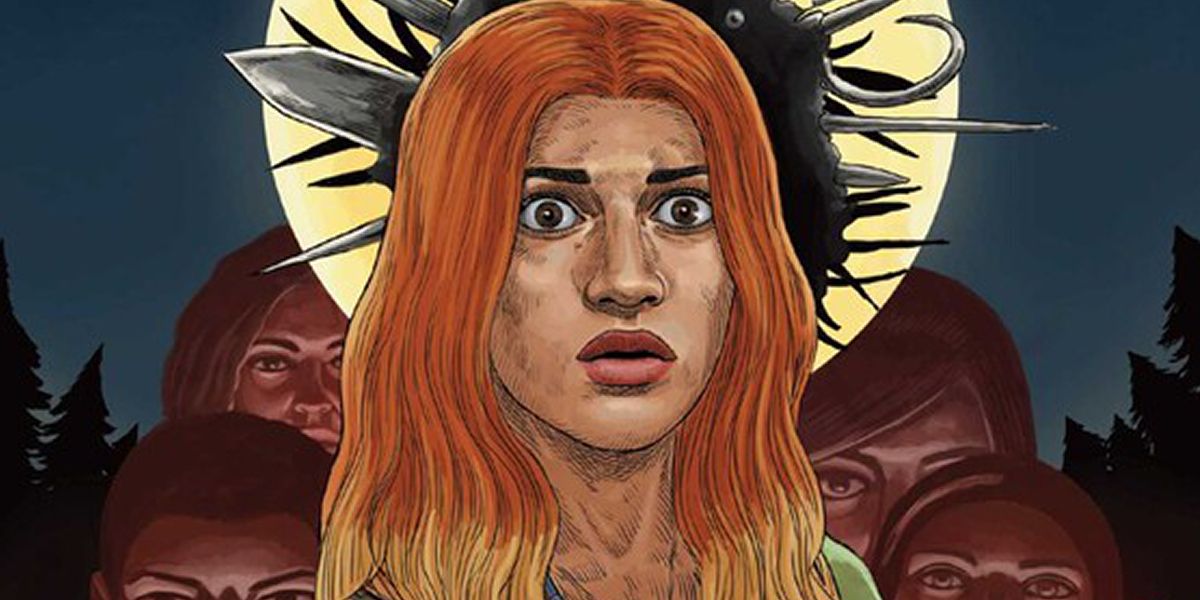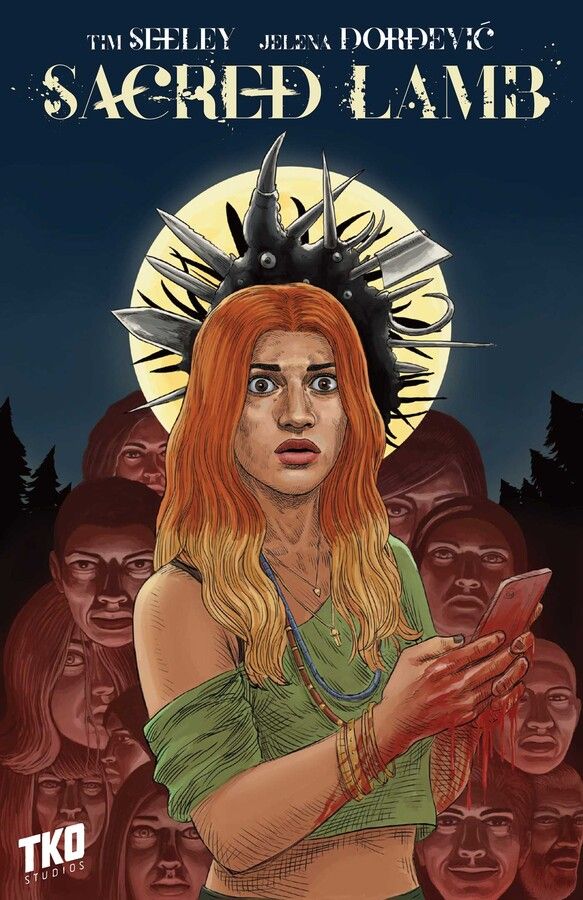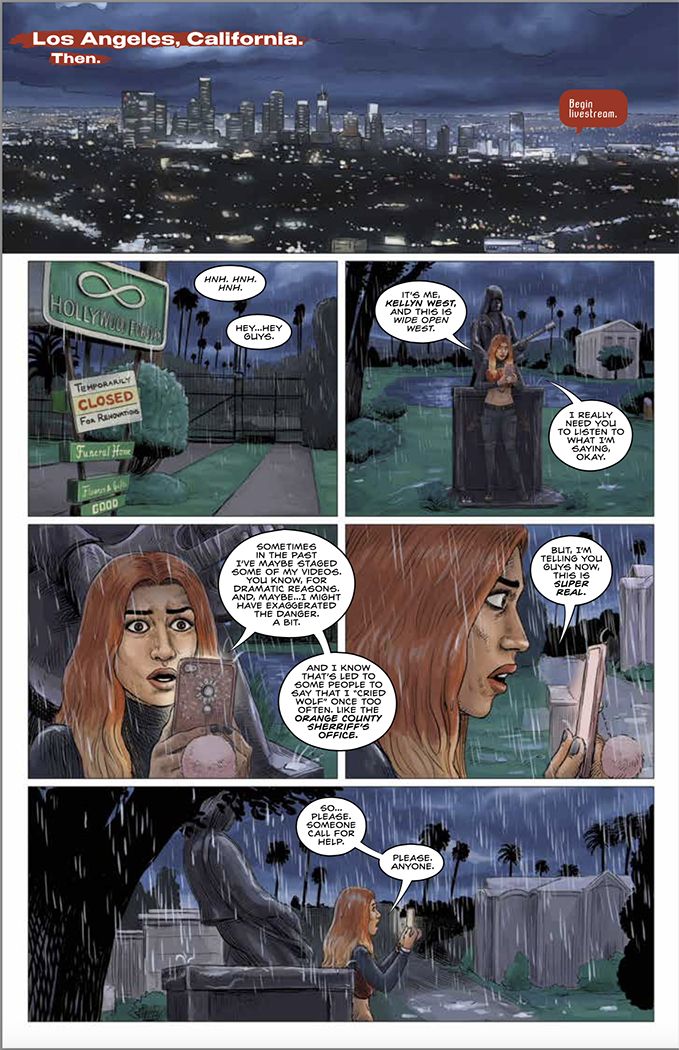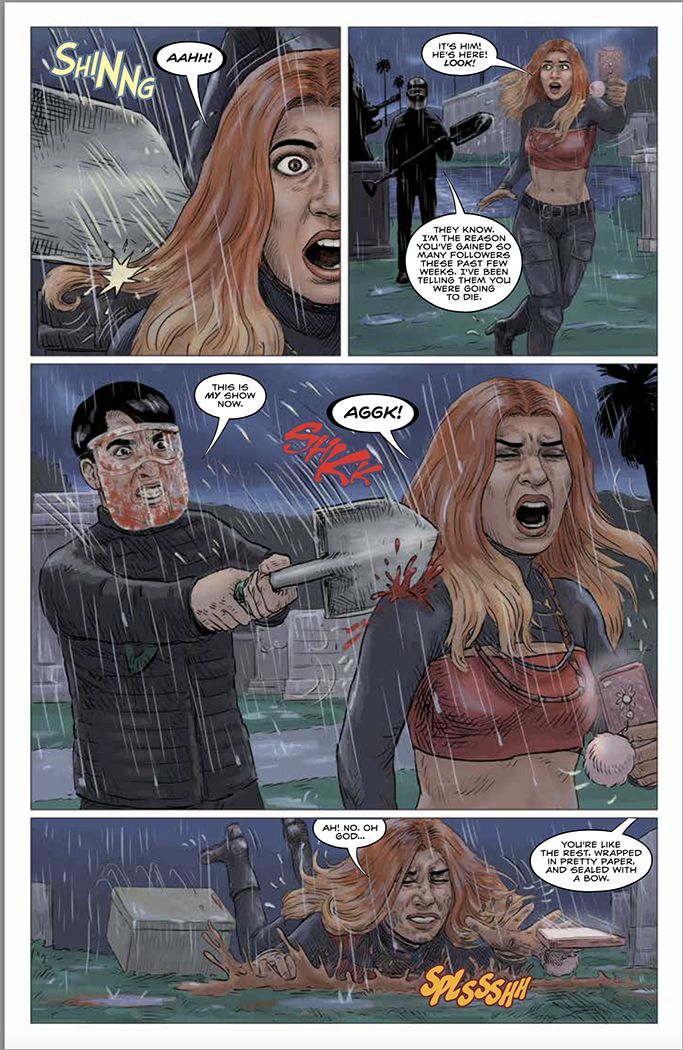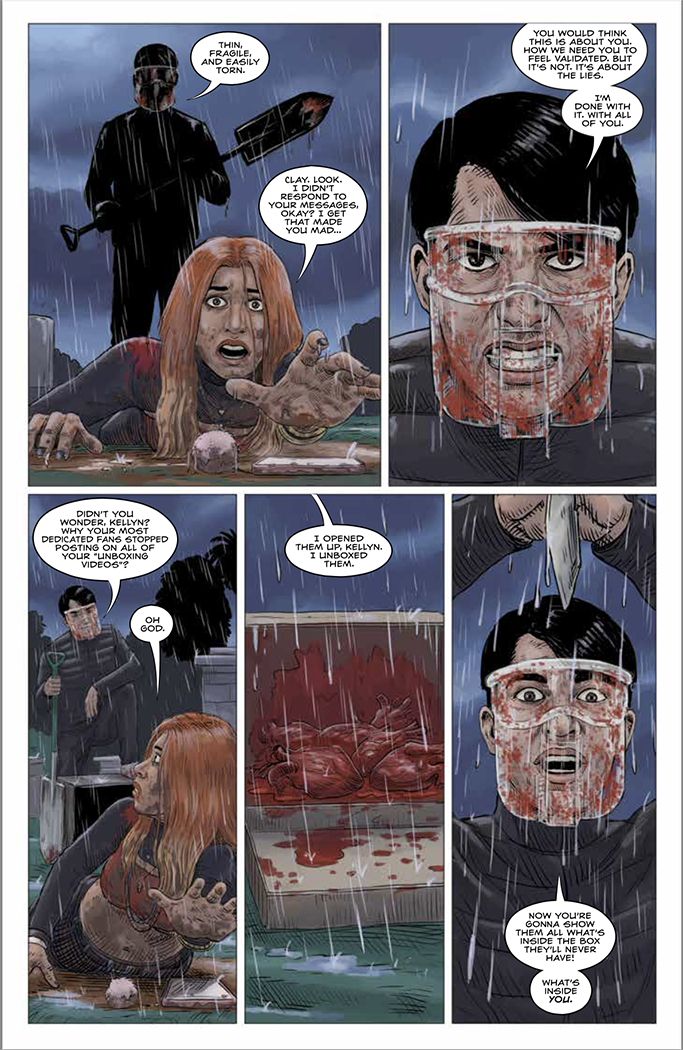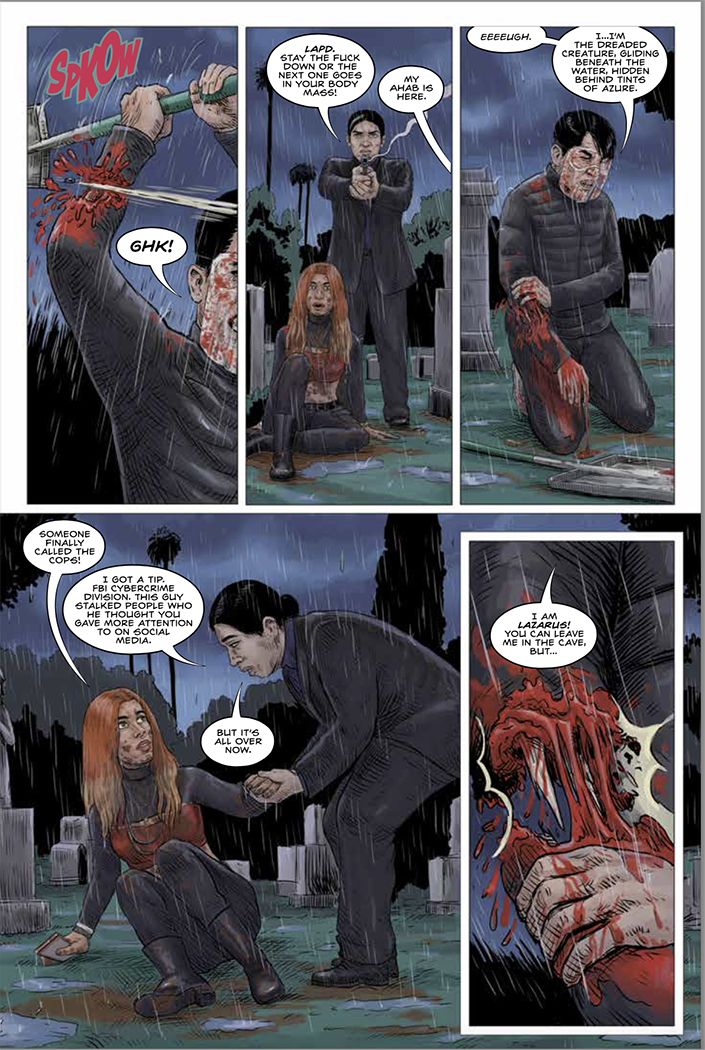The slasher sub-genre's final girls and the monstrous killers they battle have been a big part of the comics world, in large part thanks to the work of writer Tim Seeley and his most famous creation, Hack/Slash. Seeley co-created the series back in 2004 with artist Stefano Caselli. It followed the humorous, horrific, and tawdry exploits of final girl, Cassie Hack, and her hulking partner Vlad as they traveled the country dispatching supernatural killers. It ran until 2015, but since then, Seeley has returned to the series for a number of stories.
Next year, the writer will revisit the world of slashers in Sacred Lamb, a decidedly different, meta-horror graphic novel from TKO publishing that digs deep into some underlying themes of the genre. CBR spoke with Seeley about the book, which features art by Jelena Ðordevic-Maksimovic and follows the exploits of a modern-day final girl who's forced into a witness protection style town with several other survivors. He chatted about the origins of his story, how it differs from Hack/Slash, its diverse cast of final girls, and the army of slashers they'll be forced to confront.
CBR: The slasher genre is enjoying a sort of renaissance. Why do you think that is? What makes slashers so resonant?
Tim Seeley: Every time there's any kind of moral panic in America, it tends to be followed by slasher movies like in the late '70s and the mid-'80s. Generally, it happens when some very religious people get very aggravated about changes in society. So, they start to envision all these horrible punishments that must befall people. Then the producers who make these films go, "Kids are feeling this sense of persecution. So what will scare them is to see that executed. They'll pay to see that on the big screen."
The films supply this much-needed venting for kids who are put under this stuff, as well as kind of a sick pleasure for those who would persecute kids for being sexual or going outside the system they've established. What we're also seeing, and I find very interesting, is when these moral panics happen the movies tend to focus on that. For instance, there's a movie out with Kevin Bacon called They/Them, which is a slasher story set inside a gay reprogramming camp. So, slashers are always socially relevant because there's always this religious, conservative backlash.
Sacred Lamb continues your exploration of what happens to the final girls of slasher films, dubbed "endemic victims" in this book, after their initial encounter with a killer. It puts a unique twist on it, because it's about a witness protection style town for final girls. What inspired this idea, and how did it develop?
I started developing this back in 2019. I originally thought of it as a Hack/Slash story. Then the pandemic occurred, and the idea of people thinking of victimhood spreading like a disease became even more important and interesting to explore. I took Cassie out of it and put in a new character, so I could build different mythology. This story would have a different take, and a Hack/Slash story is inherently about exploitation in the slasher movie. It's kind of kinky and sexy, and I felt like this couldn't be that because it was so much about abuse and the way society punishes women for its abuse of them. So kinky, sexy stuff didn't work.
It then became its own thing, and once I started working with TKO, my editor Sebastian Girner really pushed me to flesh out this mythology and make it a bigger world with a long history of these women going back to the late '70s. That's when slasher films started showing up.
Your protagonist is a very modern woman named Kellyn West. What do you want readers to know about her?
I wanted to have a character where we could play with the idea of someone who lives a public life. So many younger people now have figured out a way to live publicly. They have a YouTube channel, or they're an influencer, a TikToker, or whatever. They live very publicly, and I assume that comes with pluses and minuses. So, I wanted part of this story to examine what happens when someone who lives in that public space is transported to this walled city where her communication with people in the outside world could lead to their death. She could be stalked for having fans or friends or anything that could lead a slasher to become obsessed with her. I wanted Kellyn to be the epitome of that.
One of the fun things about Sacred Lamb is it features a supporting cast of endemic victims from a multitude of slasher eras. What can you tell us about them?
The idea is that this town has been populated with these endemic victims for at least 40 years. So, we have a character who's very clearly from a '70s-style slasher movie. There's a character from an '80s "Satanic Panic" slasher. We have characters from '90s slasher movies and everything in between.
So, one of the big themes in this story is that this keeps happening, but in every era, it happens differently. So, the idea is to show these different eras as they relate to the kind of horror that was made. What was the moral panic at that time? What were they trying to exploit in that era? So these women have spent years, and some of them even decades, living in this closed-off commune. Kellyn is supposed to be here for the rest of her life, and she's startled to see what happened to them.
Also, by design, that allows us to do an Agatha Christie Ten Little Indians-style story where we're not sure who the killer is. The mystery is that they start bumping each other off, and questions arise like, "Has one of them been contaminated and gone crazy? Is it someone coming at them from outside?" It really lets us do a tense, murder mystery-style slasher story.
The other cool element of Sacred Lamb is it features a diverse cast. For example, the Babysitter is an homage to Laurie Strode, but in this story, she's a person of color.
Yeah, if you go back to the eras when these movies were made they tended to largely be white. We wanted to have different kinds of characters and pick up on things that would be different if you were casting someone less because of the era and more realistically. So, a little of the Babysitter's character is informed by her race.
Our cast is almost all women, with the exception of one gay man. Since these are all final girls, that's a reference to A Nightmare on Elm Street 2, which was essentially, whether they knew it or not, the first gay slasher film. We wanted to include that character because it allowed us to tell the story from a different perspective of the slasher genre
This is a meta story, but you're not just looking at American cinema. There's a nun character and her daughter that very much feel like a nod to Italian horror.
Italian horror tended to be more violent, weirder, and more sexy. [Laughs] So, that felt like it had to be part of those characters. Our nun was censured in the '80s and had a daughter who grew up essentially behind these walls. [She] feels like her life was stolen because of what happened to her and her mother, which makes for a pretty interesting dynamic among these people.
Again, we're talking about a very tense story with people who've been traumatized, and there's this weird assumption made by law enforcement in this story. It's that "These people can't be trusted because they've been victimized." That's such a crazy idea! They should be helping them! But they put them away. They punish them for being hurt.
What else can you tell us about the titular town of Sacred Lamb?
It's based on real stuff that I discovered when I was researching Revival. This was before Covid by about five years, and I had read about the only quarantines in American history; where they actually shut places down before Covid. That led to looking into internment camps as well. In a lot of ways, there's an overlap there between what people were accused of and what was considered dangerous. So I combined it with some of those factors. So even though the town is somewhat made up, it's also based on truth.
One of my favorite things about it is they try to give them this sort of perfect Americana town, but it's completely locked into the era when it's developed. So they're living in this late '70s/early '80s town that's fallen into disrepair and these women have to make due in this strange place. It contains lots of terrible secrets as well.
As the story moves forward, an army of slashers descends on the town. What was it like creating those slashers with your artist Jelena Ðordevic-Maksimovic? What can you tell us about them?
[Laughs] I've obviously done this a few times. So, the difference I really wanted to push with this story is that the slashers in Hack/Slash are more cartoonish. I wanted it to be that way because Hack/Slash is very much that kind of comic. With this, I wanted to lean more into what these people would be like in real life.
Jelena's style works really well with that because she has this very aggressive, weird, things are off, sort of off style. So we can make these really unsettling slashers that are too close to reality. We also wanted these slashers to reflect their victims. So, to some degree, they're epitomes of their era. The '80s slashers were often rooted in the Satanic Panic stuff. Earlier eras tended to revolve around kids left alone; the babysitter murders-style stories. So we let our designs be influenced by the world from which they came.
The Slashers and the struggle for survival is the fun frosting of Sacred Lamb, but it sounds like the heart of this story is a look at trauma, how society treats survivors of violence, and sexism Is that what you and Jelena were aiming for?
Absolutely! I don't want to give anything away, but when you realize what these slashers are, I think it becomes very clear what sort of societal issues we're pushing back against. It's something that's become even more prevalent in the last four to five years.
So, yeah, it's really about things like how men tend to react to women gaining rights, power, and voices and how that's always been a part of slasher stories. To some degree, it's always about women, victimization, and the social conflict of the time. That's always been part of those movies. You see it to this day. The slasher movies that have come out since we wrapped the script on this book are clearly epitomizing that idea.
Finally, the slasher is perhaps the most sequel friendly of all horror sub-genres. If people show up for this, do you see yourself revisiting the characters and the world of Sacred Lamb?
The initial name for slashers in our story was "sequel killers." [Laughs] So, it's definitely built into this idea; the fact that they keep coming back and how they come back. There are rumors in the story about things like an "unknown return." Can someone come back from the dead? That question is a very central theme to this story and sets us up for a lot of the ideas that we end with.
So, yeah, I could definitely do another one. I have some thoughts. Plus, this is built to be very flexible. Because there are different eras of slasher stuff, some of them are combined with other genres, which is what Sacred Lamb is. It's sort of a slasher movie plus Die Hard. So, we could do a slasher movie, plus a bunch of other genres.
What about flashback stories about the supporting characters?
[Laughs] Yeah, there's a lot of backstory here. We see bits of it when they talk about their lives, but we could do their origins or what happens to them after. There's a ton of story potential here, and what I really love to do with this stuff is lay the groundwork for a multitude of things. I then let the readers react to it and see what excites them, and what they want to know more about. That's how we did Hack/Slash for 20 years. So I figure it's about time for a refresh.
Creating Sacred Lamb with TKO has been great. Sebastian Girner was so helpful and always a guiding hand. It was such a nice process to be able to do what's essentially a creator-owned book, but with the same type of attention, and perhaps more, as if I was doing a superhero crossover event.
Sacred Lamb is due out from TKO Studios in April 2023.

